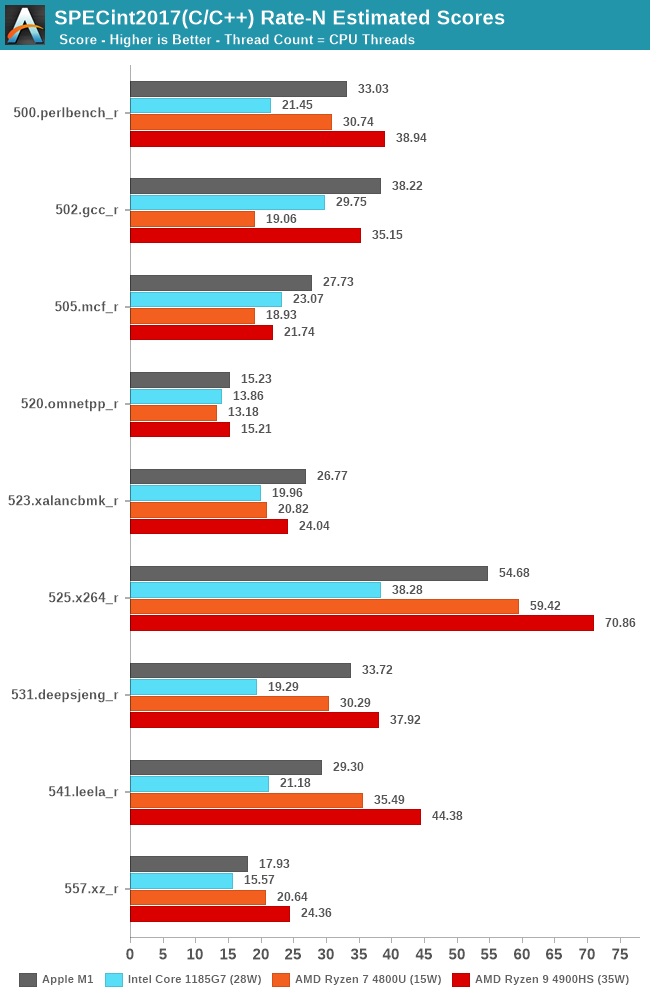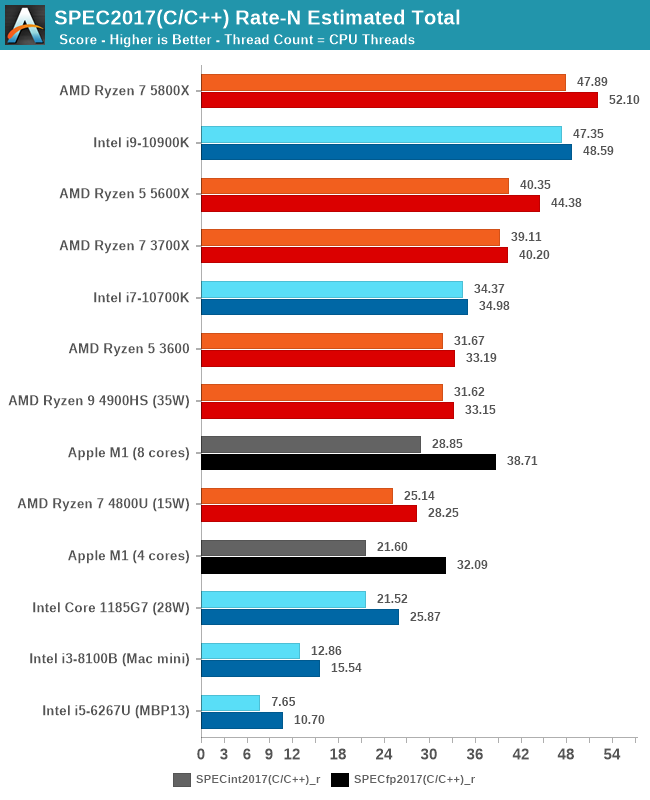The 2020 Mac Mini Unleashed: Putting Apple Silicon M1 To The Test
by Andrei Frumusanu on November 17, 2020 9:00 AM ESTSPEC2017 - Multi-Core Performance
While we knew that the Apple M1 would do extremely well in single-threaded performance, the design’s strengths are also in its power-efficiency which should directly translate to exceptionally good multi-threaded performance in power limited designs. We noted that although Apple doesn’t really publish any TDP figure, we estimate that the M1 here in the Mac mini behaves like a 20-24W TDP chip.
We’re including Intel’s newest Tiger Lake system with an i7-1185G7 at 28W, an AMD Ryzen 7 4800U at 15W, and a Ryzen 9 4900HS at 35W as comparison points. It’s to be noted that the actual power consumption of these devices should exceed that of their advertised TDPs, as it doesn’t account for DRAM or VRMs.

In SPECint2017 rate, the Apple M1 battles with AMD’s chipsets, with the results differing depending on the workload, sometimes winning, sometimes losing.

In the fp2017 rate results, we see similar results, with the Apple M1 battling it out with AMD’s higher-end laptop chip, able to beat the lower TDP part and clearly stay ahead of Intel’s design.

In the overall multi-core scores, the Apple M1 is extremely impressive. On integer workloads, it still seems that AMD’s more recent Renoir-based designs beat the M1 in performance, but only in the integer workloads and at a notably higher TDP and power consumption.
Apple’s lead against Intel’s Tiger Lake SoC at 28W here is indisputable, and shows the reason as to why Apple chose to abandon their long-term silicon partner of 15 years. The M1 not only beats the best Intel has to offer in this market-segment, but does so at less power.
I also included multi-threaded scores of the M1 when ignoring the 4 efficiency cores of the system. Here although it’s an “8-core” design, the heterogeneous nature of the CPUs means that performance is lop-sided towards the big cores. That doesn’t mean that the efficiency cores are absolutely weak: Using them still increases total throughput by 20-33%, depending on the workload, favouring compute-heavy tasks.
Overall, Apple doesn’t just deliver a viable silicon alternative to AMD and Intel, but actually something that’s well outperforms them both in absolute performance as well as power efficiency. Naturally, in higher power-level, higher-core count systems, the M1 can’t keep up to AMD and Intel designs, but that’s something Apple likely will want to address with subsequent designs in that category over the next 2 years.










682 Comments
View All Comments
Hrunga_Zmuda - Wednesday, November 18, 2020 - link
You clearly are not a real Apple developer, you are a Windows developer forced to violate your prejudice. There are plenty of top-flight developers who love to develop for MacOS.Spunjji - Thursday, November 19, 2020 - link
Most of the devs I know like macOS as a development platform *and* as a target, and none of them are Apple fans outside of that. I guess it varies.allajunaki - Tuesday, November 17, 2020 - link
On the contrary, one of the first thing they showcased in the initial demos were running virtualization and Linux.andreltrn - Tuesday, November 17, 2020 - link
Yes for for web developers that is important. Most web app run on linux not windows. I recruit developers for the IT industries and most of the server apps are developed for Linux servers.toke - Tuesday, November 17, 2020 - link
It would have been so nice to compare this to mini 2018 i7 (I7-8700B + uhd630),meh...
Ryan Smith - Tuesday, November 17, 2020 - link
There are about half a dozen further Macs I would have liked to include. Unfortunately securing them is easier said than done, especially in the middle of a pandemic. So we had to take what we could get.The i7 would certainly have performed better than the i3 on the CPU side thanks to the additional cores and added frequency. The GPU side would have been almost as dire, however. Apple really wants to move the baseline for their systems far beyond what Intel (and really, the other PC OEMs) deem acceptable.
DeathArrow - Tuesday, November 17, 2020 - link
Does it run Crysis?Ryan Smith - Tuesday, November 17, 2020 - link
Sadly, no. There never was a Crysis port for the Mac. In fact without Bootcamp, it's even less capable of running Crysis than the 2018 Mini.Silver5urfer - Tuesday, November 17, 2020 - link
Ask about SOTTR, yeah it exists on Mac OS and with proper port. But it won't be able to run as there are GPU requirements in play which Apple can never match, due to VRAM plus the Rosetta2 layer so the dev Feral should update it. So unless they do that there's no gaming benches which are big ones not the garbage Apple arcade mobile ones.tipoo - Tuesday, November 17, 2020 - link
I believe Apple had mentioned 128 ALUs per GPU core at the keynote around the same time they mentioned the flops, so that's confirmed.Worth keeping in mind, this is the slowest M chip Apple will ever ship, the very baseline, and it's already doing this. Can't wait for the "ARM can't scale" x86 die hards to pretend they never said such things.